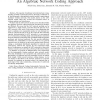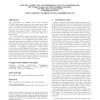275 search results - page 46 / 55 » Distributed interference compensation for wireless networks |
JUCS
2008
13 years 7 months ago
2008
: Multi-Agent Systems (MAS) constitute a well known approach in modelling dynamical real world systems. Recently, this technology has been applied to Wireless Communication Systems...
CORR
2011
Springer
13 years 2 months ago
2011
Springer
Abstract—The capacity of multiuser networks has been a longstanding problem in information theory. Recently, Avestimehr et al. have proposed a deterministic network model to appr...
MOBISYS
2004
ACM
14 years 7 months ago
2004
ACM
The performance of Wireless Local Area Networks (WLANs) often suffers from link-layer frame losses caused by noise, interference, multipath, attenuation, and user mobility. We obs...
INFOCOM
2010
IEEE
13 years 6 months ago
2010
IEEE
—In IEEE 802.22 Wireless Regional Area Networks (WRANs), each Base Station (BS) solves a complex resource allocation problem of simultaneously determining the channel to reuse, p...
DSN
2003
IEEE
14 years 25 days ago
2003
IEEE
The presence of physical obstacles and radio interference results in the so called “shadow regions” in wireless networks. When a mobile station roams into a shadow region, it ...


